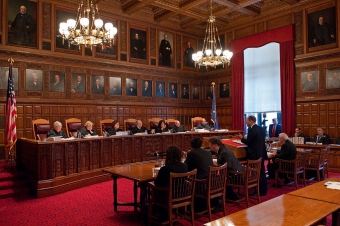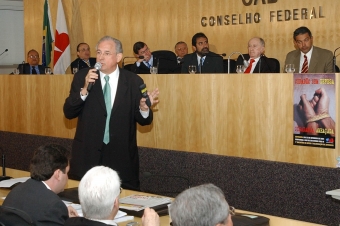Summary:
It is based on Problem-Based Learning in a specific segment of the Legal Sociology class, discussion about Alternative Law. Throughout this activity, students could experience the resolution of concrete cases by an alternative interpretation, as well as acquiring critical and communication thinking abilities and skills. In the end, students were evaluated and got the solution for the solved problems, and also they could participate of a probe/inquiry (diagnosed search) about their perception around the developed activities and its impacts at the learning process.
Objective:
- GENERAL GOALS: The goals persecuted by the class and the specific activity were aligned with the profile of the student, conforming the Law Course Pedagogical Project (LCPP) at the Antônio Eufrásio de Toledo de Presidente Prudente University Center. Additionally, using their LCPP, the institution has the goal of graduating a professional who “has ethic and responsibility sense, discernment capacity to judge and choose from the alternatives, critical thinking, reasoning agility, and capacity to relate with people. {…}”. Thus, the Sociology class is supported by teaching strategies guided at the student protagonism, which can contribute significantly to prepare the students to the job market, making stronger the acquisition of abilities and critical thinking, ethic and responsibility sense and the capacity to solve problems;
- SPECIFIC GOALS: As a specific goal, the activity tried to stimulate the students’ critical reasoning by the study of concrete cases, developing the abilities to put themselves with an alternative and creative form facing the traditional legal paradigms;
- DEVELOPED ABILITIES: It was pretended to develop the critical thinking capacity, group work and oral and written communication.
Dynamics:
- TEACHING METHOD: problem-based learning
- REQUIREMENTS: In relation to the students, the preparation consisted on a previous study through reading and video (documentary about conflicts involving the urban possession – the Pinheirinho case).
In relation to the professor, it involved a study about the PBL methodology through reading about the theme reference work, also with the participation and graduation at the active methodologies through Sthem Brasil/LASPAU-Harvard consortium. In addition, the activity preparation also required the formulation of relevant problem-situations to the social context and suitable to the theme treatment, as well as the design of discussion and evaluations items for the students’ answers, which is available at attachment 1.
- DEVELOPMENT OF THE DYNAMICS: The applied activity constitutes inside the problem-based learning (PBL) and talked about the conflict resolution for the possession of the land by alterative interpretation of jurisdictional instance.
The thematic was chosen for the activity is related to two big topics of the class programed contents: 1) Legal Pluralism; 2) Alternative Law. In addition to the instructional approach for hybrid PBL, the contents were worked using the brief case discussion (short cases) and systematization.
The didactic sequence involves six main stages, as we describe here:
1st stage: Material availability for previous study.
Through the virtual tool Student Portal, were made available previously to the student the class’ syllabi, obligate and complementary reading indications and a documentary ("Somos todos Pinheirinho") about the result of the reintegration of registered possession in an area that was occupied by homeless families.
2nd stage: Problem-situation presentation and discussion.
In class, it was started the first PBL tutorial session. It was presented to the students the main incidents involved at the problem-situation (as seen at attachment 1), which told the occupation of popular houses by homeless families and the request for repossession from companies owing the real estate to the Judiciary Court. Furthermore, it was asked that each group discussed the elements of the problem (as seen in the picture available in attachment 2), stablishing solving hypotheses. The goal was that each group presented, in the end of the session, a legal and extra-legal solution for this concrete case.
3rd stage: Brainstorming
In the end of the group discussion (50 minutes), the groups passed to relate the solving hypotheses. The professor registered on the black board (as seen in the picture available in attachment 2) the solutions ways proposed by the students, which translate themselves in three principal strands: a) concession of the repossession (professor observation: majoritarian position inside the groups, which reflect the strong ideological shades involved at this conflict type and a impregnated legal positivism reigning in common sense); b) Expropriation of the houses by the Executive Court and/or assistant measures, like the temporary shelter grant for families; c) The no award of the injunction of the repossession (hypothesis presented by just one group), countering the hegemonic right. It was seen that the class theme and the class programmatic content talked specifically about this last alternative solution model, which allowed the confrontation of the previous student positions with other legal paradigm.
4th stage: Concept systematization
At the following class, there were systemized through dialogued exposition the main concepts of the programmatic content. It was witnessed a bigger involvement of the student in the discussion for they had been the protagonists in an active theme learning through previous study and PBL discussion.
5th stage: New Problem proposition (evaluation)
The next PBL stage involved an individual way of resolution of a problem by the students. The activity was oriented to consolidate the learning, as well as the evaluation of the learning. In order to do this, the problem was proposed as an evaluation item (value of 3,0). During this new questioning application, students received a strong problem-situation involved at the discussion of injunction granted or not about the repossession facing the occupation of a highway continuous zone by homeless families. It was asked that the students acted as magistrates (connecting here the PBL and role play methodologies) and decided the case using an alternative interpretation. After the evaluation application, there was available by virtual environment to the students (Academic Portal and Facebook social page) the whole content of the real decision. Then, students had the opportunity to analyze the magister argumentation and compare with the decisions that were invested of a hypothetical judge paper. During the process of comparisons of students tests examples with the argumentation adopted by the judge (as seen at attachment 1), it was really good to note the capacity that the students demonstrated during their protagonism at the decision taking when they face a real case and also the understanding consistently alternative Law concepts, reflecting the critical positioning against the social reality.
6th stage: Measurement of the students’ perception about the methodology
After the completion of the didactic sequence, it was sought to probe the students’ perception about the learning by the active methodologies application inside the class. The results are described at the “Observation” tab.
- ATTENTION IN THE CLASSROOM: Prior preparation is critical to the realization of guided activities based on the students' protagonism. In this sense, it would be appropriate to apply the Just-in-time Teaching methodology or other form of assessment prior to probing questions and previous knowledge of students. The development of our activity, such assessment was made through diagnostic survey (brainstorming).
Evaluation:
- GRADE EVALUATION: Even for the class problem-situation discussion and also for the individual problem resolution in the evaluation, there were elaborated items (as seen in attachment 1) with the expected answers, also with the obligatory items for the written evaluations elaborated by the students. The activity had a significant rate at the student evaluation (3;0 points of the final evaluation with a total value of 7,0).
Observation:
1) It is suggested as consolidate activities: the search of jurisprudential/cases analogs to those discussed in class; also the field research about the agricultural and/or urban problem in the territory in which the IES is located.
2) After the completion of the didactic sequence, it was sought to delve the student’s perception about the learning by the active methodologies application inside the class. The hypothesis delved (as seen in attachment 3) was that the active methodologies, like the PBL and the cases discussion favor not only the content acquisition, but also the skills and abilities. The perception that the active methodologies stimulate the development of critical thinking (79% excellent and 18% good) and other abilities, like the communication (73% excellent and 23% good) also was highly evident in answers. Additionally, the group work abilities also had a positive result (85%, adding the “excellent” and “good”), however, they showed the biggest percentage of answer “indifferent” (10%), “regular” (3%) and “weak” (3%). Then, it was seen the possibility to stimulate more the work abilities acquisition in groups adopting other active methodology, like Team-based Learning. Nevertheless, there was highlighted that traditional methods, as the expositive class, have a really low potential for acquisition of this type of skills, which already point us a positive result with the experience.






